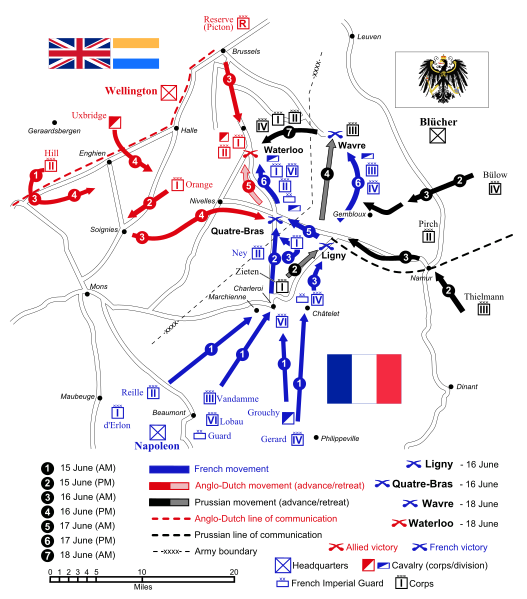
http://www.britannica.com/EBchecked/topic/219456/French-revolutionary-and-Napoleonic-wars/283823/The-defeat-of-Napoleon
The overthrow of Louis XVI and the establishment of republican government placed France at odds with the primarily monarchical and dynastic governments of the rest of Europe. In the Declaration of Pillnitz(1791) Austria and Prussia issued a provocative general call to European rulers to assist the French king reestablishing himself in power. France declared war in April 1792. On September 20, 1792, French forces under Charles-François Dumouriez and François-Christophe Kellermann turned back an invading Prussian-Austrian force at Valmy, and by November the French had occupied all of Belgium. Early in 1793 Austria, Prussia, Spain, the United Provinces, and Great Britain formed the first of seven coalitions that would oppose France over the next 23 years. In response to reverses at the hands of theFirst Coalition, the Revolutionary government declared a levy en masse, by which all Frenchmen were placed at the disposal of the army. By that means unprecedentedly large armies were raised and put in the field during this period. Battles on the Continent in the mid-18th century typically had involved armies of about 60,000 to 70,000 troops, but after 1800 Napoleon routinely maneuvered armies of 250,000; and he invaded Russia in 1812 with some 600,000. (See map.)
The rise of Napoleon
By early 1795 France had defeated the allies on every front and had pushed to Amsterdam, the Rhine, and the Pyrenees; more importantly, Prussia had been forced out of the coalition and had signed a separate peace that held until 1806. In May 1795 the United Provinces of the Netherlands became the French-influenced Batavian Republic. In northern Italy, a strongly positioned French army threatened Austrian-Sardinian positions, but its commander proved reluctant to move. In March 1796 he was replaced by a more dynamic general, Napoleon Bonaparte.
Napoleon executed a brilliant campaign of maneuver against Austrian and Sardinian forces in Italy and in the resultant treaty of Campo Formio forced Austria to cede the Austrian Netherlands (now Belgium and Luxembourg), which became the first territorial additions to the French Republic, and to recognize the Cisalpine and Ligurian republics established by French power in northern Italy.
Napoleon’s next campaign was a major failure. He sailed an army to Egypt in May 1798 with the idea of conquering the Ottoman Empire. The defeat of a French naval squadron by Admiral Horatio Nelson in the Battle of the Nile (August 1, 1798) left him without sufficient naval support, however, and, after failing to take Acre in 1799, Napoleon withdrew to France. His army continued to occupy Egypt until 1801. Meanwhile, other French forces had occupied new territories and established republican regimes in Rome, Switzerland (the Helvetic Republic), and the Italian Piedmont (the Parthenopean). As a result the Second Coalition formed, comprising Britain, Russia, the Ottoman Empire, Naples, Portugal, and Austria. The allies’ initial successes were reversed by their inability to agree on strategy, however, and by the time Napoleon became the first consul of France by the coup d’état of 18 Brumaire, year VIII (November 9, 1799), the danger of foreign intervention against the Revolution in France was over. A victory over Austria at Marengo in 1800 and the consequent Treaty of Lunéville left France the dominant power on the Continent. For two years thereafter only Great Britain, with its powerful navy, remained to oppose Napoleon. Nelson’s smashing victory at Trafalgar (October 21, 1805) ended a French threat to invade England. In 1805 a Third Coalition formed with Britain, Russia, and Austria. Napoleon won major victories at Ulm and Austerlitz in 1805 and at Jena, Auerstädt, and Lübeck over the new coalition member Prussia in 1806. The resulting Treaty of Tilsit, in which Prussia was halved at the Elbe and also lost part of Poland, and the Treaty of Schönbrunn in 1809, following a brief Austrian uprising, left all of Europe from the English Channel to the Russian border, with the exceptions of Portugal, Sweden, Sardinia, and Sicily, either part of the French Empire, under the control of France, or allied to France by treaty.
In 1806, in an attempt to use French control of continental ports to blockade Britain indirectly, Napoleon issued the Berlin Decree, by which ships passing to French-controlled ports after calling at British ports were liable to seizure. The Continental System, as this policy was called, was not successful. The general inhibition of European trade that ensued (for Britain responded with a like policy of detaining ships bound for French ports) and the perceived favouritism in the French government’s granting of licenses to French merchants for trade with Britain cost Napoleon considerable political support. Meanwhile, though pressed at home, the British were able to expand their colonial markets so as to emerge from the trade war more prosperous than before.
No comments:
Post a Comment